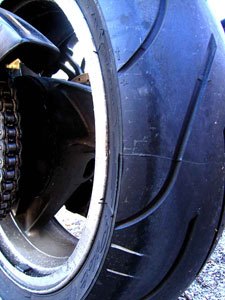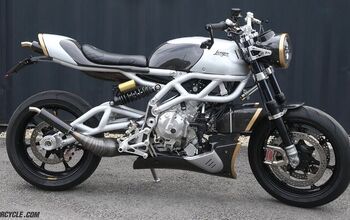Michelin Pilot Power 2CT Tire Review
Along Rt. 340 by Virginia’s Shenandoah Mountains I knew it was time. For new rubber, that is. Flying the test mule – a ‘92 ZX-11 - up hill and down dale, the rear was drifting of its own accord. And this time it wasn’t even raining.
Fact is, the Bridgestone BT012R Battlaxs (an improvement over the OEM BT-54s) had given yeoman service for something like 8K miles. Wet, dry, freezing cold, blue-blazes hot; bumpy, jumpy, groovy, gravelly, gnarly, expansion-jointy or pool-table smooth made little difference. Predictable as dirt, they were. Saved my bacon more than once while insanely confusing myself with Nicky Hayden. Sure, the center tread was whispering buh-byee, but that’s in a tire’s nature.
‘Til now. Meet Michelin’s Pilot Power 2CT, a by-product of the French firm’s many racing triumphs and successor to the popular Pilot Road, these radial skins are meant to carve a new niche. Made with hard and soft compounds front and rear, their sidewalls are extra grippy while the midsection is tougher, the manufacture asserts.
Plus, unlike other makes’ dual-compounds, Michelin’s PP2CT boasts a dual-compound on the front tire as well. Meaning, theoretically, quicksilver handling, but much longer life than race-rep compounds which can turn slick after a few thousand miles.
The PP2 CTs, Michelin asserts, "use three new silica-reinforced tread compounds. Developed from MotoGP rain tires, the silica component helps provide grip and progressive responsiveness on cold, wet surfaces... The front tires integrate a soft compound, while the rear tires are made with a harder compound that can withstand greater demands during acceleration. The rear tires also have a slightly softer section, part of which is in contact with the ground even when the motorcycle is fully upright. This facilitates warmup, and, consequently, grip."
Actually, the 180/55-ZR17 rear and 120/70-VR17 front signaled something different right from the start. Unlike other new tires, which in any kind of turn can yield a woozy “tip-in” tendency for miles, the PP2 CTs felt dead neutral within a few blocks. Encouraging. They also warmed fast, even in temps down to the high 40s. Confidence-inspiring? Oh yeah.
It only got better. Soon, I was moving from being an okay, slightly-timorous-in-the fastest-stuff rider (“Hey, guys, the ZX-11 is a heavy bike!”) to well, not Nicky Hayden, but a lot more confident version of me. It was as though the Zixxer had shed about 50 of its 540-lb. pounds; practically seeming the weight of a 750. Wondrous sensation, this!
Handling was considerably transformed. As for the PP2 CTs’ tread designs (looking like fast sweepers out back, hairpins in front) they’re impetus enough to get you out to find similarly-shaped roads.
Cushiness was an interesting by-product. The bike jolted less over rough or pitted tarmac. With a “hard” center compound I wouldn’t have expected this. What I would have expected is a little slip-slidin’ in the wet. Granted, we never got into any highway downpours. But in the “moist,” at 40-50 mph in some parkland twisties, grip and feedback were really good. Again, the tires raised the confidence ante.
Other moto-scribes report serious adhesion. In a long track test with sprinklers keeping the road surface wet, one tester reported 30% better lap times. This news is as surprising as it is welcome. As touring guys will attest, long-distance tires often produce white knuckles in the rain.
Manufacturers have bombarded us over the last decade with seductive come-ons. “Cosecant-wave technology treads,” “revolutionary dual-belt constructions,” “silica-rich” compounds and So Much More. Some rubber performs as advertised, some hits wide of the mark. With the Pilot Power 2CTs, Michelin scores a bulls-eye. Might as well call these PP2CTs uber street tires. I do.
Why Two Compound Tires?
| 2009 MSRPs for Pilot Power 2CT | |
| Front | |
| 120/70ZR17 (58W) | $211.90 |
| 120/60ZR17 (55W) | $209.76 |
| Rear | |
| 160/60ZR17 (69W) | $266.40 |
| 180/55ZR17 (73W) | $272.30 |
| 190/50ZR17 (73W) | $318.76 |
| 190/55ZR17 (75W) | $331.76 |
On the PP2 CT’s genesis, functionality and benefits, Michelin’s Dan Wildhirt explains,
“One message that we're hoping to get across is that Michelin, which debuted two-compound technology for racing back in 1994, now offers a complete family of two-compound tires for sport and sport touring bikes. Your Pilot Power 2CT high-performance tires are for sport riding and track days. Some manufacturers tout the benefits of multi-compound construction for rear tires only, but Michelin offers 2CT in both front and rear tires - in all three of our product lines.
"Your earlier statement that the tires serve as 'a bridge between track and street' is apropos for the Pilot Power 2CT. The original, single-compound Pilot Power (which is still available, BTW) is a great tire for road or track riding, but the Pilot Power 2CT adds the extra edge grip from having a 20% softer compound on the tread shoulders. Tread life should be about the same, since both share the same compound in the middle of the tread. But Pilot Power 2CT tires provide some additional cornering adhesion for track days, with greater durability in most situations than a pure racing tire like Power Race.
"Racers would probably find more ultimate grip at the limit with the Power Race, but Pilot Power 2CT should maintain its performance over a longer period and through many more heat cycles. As you've experienced, they deliver a very high level of performance, but their exceptional tread life has been shown in independent testing to exceed that of other manufacturers' comparable sport-touring tires.”
More by David Walsh






























Comments
Join the conversation